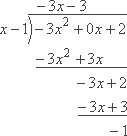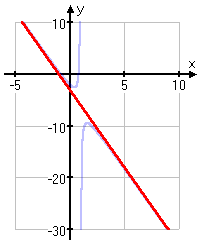Slant (Oblique) Asymptotes
In the previous section, covering horizontal asymptotes, we learned how to deal with rational functions where the degree of the numerator was equal to or less than that of the denominator. But what happens if the degree is greater in the numerator than in the denominator?
Recall that, when the degree of the denominator was bigger than that of the numerator, we saw that the value in the denominator got so much bigger, so quickly, that it was so much "stronger" that it "pulled" the functional value down to zero, giving us a horizontal asymptote of the x-axi
Reasonably, then, if the numerator has a power that is larger than that of the denominator, then the value of the numerator ought to be "stronger", and ought to "pull" the graph away from the x-axis (that is, the line y = 0) or any other fixed y-value.
To investigate this, let's look at the following function:
y=x−1−3x2+2
For reasons that will shortly become clear, I'm going to apply long polynomial division to this rational expression. My work looks like this:

Across the top is the quotient, being the linear polynomial expression –3x – 3. At the bottom is the remainder. This means that, via long division, I can convert the original rational function they gave me into something akin to mixed-number format:
y=−3x−3+x−1−1
This is the exact same function. All I've done is rearrange it a bit. Why? You're about to see.
First, take a look at the graph of the rational function they gave us:
![graph of y = [–3x^2 + 2] / [x – 1]](https://www.purplemath.com/modules/rational/asympt20.gif)
Thinking back to the results of my long division, you know what the graph of y = –3x – 3 looks like; it's a decreasing straight line, crossing the y-axis at –3 and having a slope of m = –3.
Now take a look at this second graph of the same rational function, but with the line y = –3x – 3superimposed on it:

As you can see, apart from the middle of the plot near the origin, the graph hugs the line y = –3x – 3. Because of this "skinnying along the line" behavior of the graph, the line y = –3x – 3 is an asymptote. Clearly, it's not a horizontal asymptote. Instead, because its line is slanted or, in fancy terminology, "oblique", this is called a "slant" (or "oblique") asymptote.
The graphs show that, if the degree of the numerator is exactly one more than the degree of the denominator (so that the polynomial fraction is "improper"), then the graph of the rational function will be, roughly, a slanty straight line with some fiddly bits in the middle. Because the graph will be nearly equal to this slanted straight-line equivalent, the asymptote for this sort of rational function is called a "slant" (or "oblique") asymptote. The equation for the slant asymptote is the polynomial part of the rational that you get after doing the long division.
By the way, this relationship — between an improper rational function, its associated polynomial, and the graph — holds true regardless of the difference in the degrees of the numerator and denominator. However, in most textbooks, they only have you work with a degree-difference of one.
Find the slant asymptote of the following function:
y=x−2x2+3x+2
To find the slant asymptote, I'll do the long division:
![long division, resulting in: y = x + 5, plus 12/(x – 2]](https://www.purplemath.com/modules/rational/asympt38.gif)
I need to remember that the slant asymptote is the polynomial part of the answer (that is, the part across the top of the division), not the remainder (that is, not the last value at the bottom). Then my answer is:
No comments:
Post a Comment